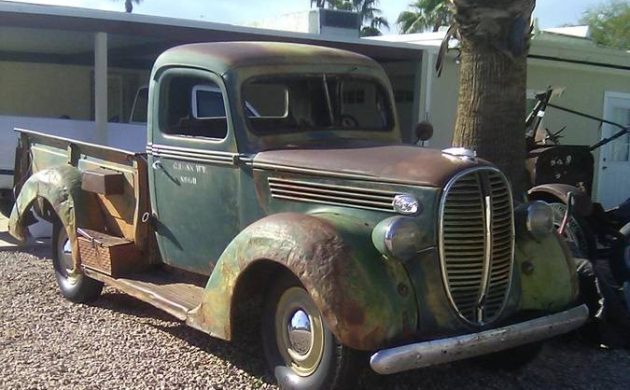
While we tend to view trucks as transportation first and tools second, before World War II it was the other way around. Trucks were spartan, utilitarian, and built primarily for hard work. Thus, good survivors are hard to find. However, thanks to intrepid reader Gunter K., a solid but worn survivor has been located for a reasonable price. This 1938 Ford 3/4 ton pickup for sale on Craigslist in Scottsdale, Arizona is not far away from being a running and driving truck. It also has a minimum of rust and the asking price is a reasonable $5,250. Is this collectible truck, which amazingly left the factory with a V-8 60 under the hood, one that you might want to add to your collection?
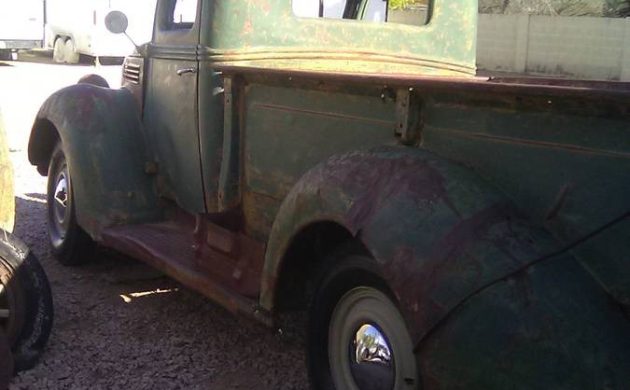
The shift in thinking on trucks can be traced back to the late sixties when manufacturers started dipping their toes into making trucks more luxurious by adding options for customers to tailor their trucks towards comfort. Chevrolet Cheyennes starting in 1971 and Ford Lairats beginning in 1978 marked the start of the “luxury truck” as a subsegment of the market. These “Cowboy Cadillacs” as they were called added car-like features, distinctive trim, and a higher price tag to your average work truck. Now, even mid-level trim packages rival the nicest cars in accommodations. It is no surprise that most used trucks have near-perfect beds. You could even go out on a limb and say that the near extinction of rear-wheel drive cars contributed to so many buyers moving over to trucks to get the vehicles they want.

Roll the clock back to the thirties and you can see just how spoiled we have become. While many of the high-tech standard features we enjoy today on even the lowliest vehicles were not in existence, most cars were built to be and marketed as comfortable. The more you spent, the better your experience. Not so with trucks. Often one of the cheapest vehicles available, your options tailored the vehicle to the type of work you expected to do. A radio was considered an extravagance, and wide whitewall tires were not a common option despite what you see on restored trucks today.
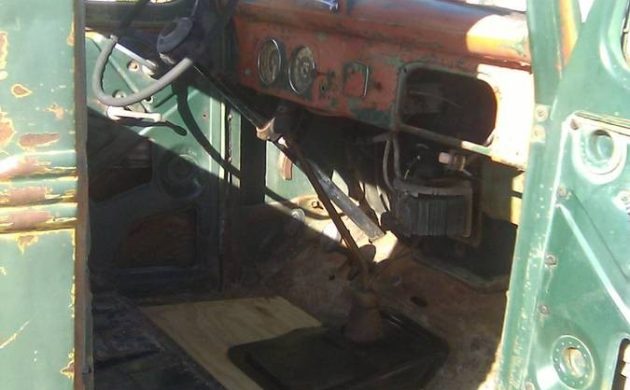
The 1938 Ford 3/4 ton pickup you see here is a case in point. This truck was ordered with a 3/4 ton payload capacity and a long bed. Most interestingly, it came with Ford’s smaller V-8 60 engine. Production of this smaller Flathead engine was started in 1937, and designed to be more efficient and less costly. It also had a reputation for not pushing a Ford car down the road with anything that might approach hastiness. In a loaded down 3/4 ton truck, speed would probably be best described as glacial.
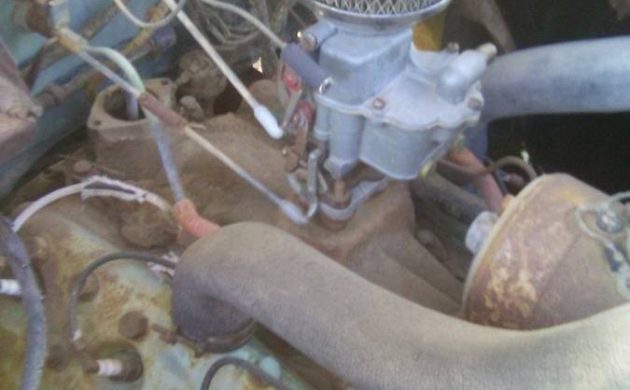
A previous owner must have thought so, as the truck now has a proper full-size Flathead under the hood. It currently does not run and we are not given any information as to its status. It could be frozen solid, or it could just need a fuel system cleanout and a battery. Who knows? What we do know is that the truck is advertised as having very little rust. Most importantly, the cab corners appear to be intact and the rust looks to be just surface rust.

The roughness of the fenders and bed are clues as to how hard this truck’s life was. This also brings you to a point where you would have to decide how to proceed with this truck if you purchased it. The Scottsdale climate allowed it to spend its life outdoors with little rust damage. If you could leave it the way it is and just get it to a point where it was reliable to drive, then it would make a cool run-around town vehicle. However, if your climate conditions are like those of the rest of the country, then refinishing it would be a wise step. Anyone who mentions flat clearing the body like Gas Monkey does will be barred from Barn Finds for life.
What would you do with this Flathead hauler? Please share your thoughts in the comments.







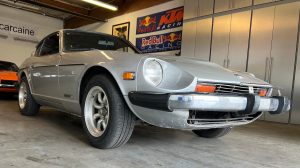


Wrong engine that doesn’t run but yeah let’s call it a survivor. Anyone who would pay more than $2500 for this parts truck is out of their mind.
The rear fender looks about what I would expect if I tried to do bodywork on a truck.
Local rig – not sure if I’ve seen it but it looks familiar.
Looks like a Roadkill style road trip! I would fly to AZ, get it running and stopping then drive it back to PA. However, I would have to pay the RKS’s suggested $2.500 less the plane ticket. Who wants to ride (work) along?
Thank you, Jeff, by gar, an old truck. It’s been a while. The authors depiction of trucks is pretty much accurate. Late 60s and most the 70s, trucks were still trucks, but a bit more respect. I mean, look at this truck. Nary a panel without a dent of some sort. Looking at vintage city street scenes, trucks are always these haggered, fender missing, clods, doing mostly dirty jobs. Imagine the poor guy that had to drive these in those conditions. Most were driven in tight areas by feel, was no big deal. That’s what trucks were for. This truck cost a whopping $580 bucks new. The 85 hp motor was $10 bucks more. As the author states, a radio was almost $50 bucks, installation extra, and a heater $19. For many, those were not necessary in what this vehicle was for. $600 bucks was indeed a lot of money, especially for farmers, who at the time, was the lowest paid profession in America.
This truck? No question, an amazing find for what it is. You wouldn’t think by looking at it, but one of the most beautiful designs, destined to be a resto-mod, and that’s okay. It’s going nowhere like this.
That original V-8 60 probably blew sky high in 1940. If you actually used it like a 3/4 ton truck.
Saw a restomod of one of these and it was a beauty. Just enough ’30s car art in the design to do anything you want here. Me, after seeing the restomod, I’d go do the same with this one.
junk
This isn’t today’s 90,000 thousand dollar truck.
Give me a Bluetooth speaker and Pandora.
This old girl is banged up and dented to pieces, and she’s not running either. It’s not priced crazy for doing a custom build project, but forget making it a faithful restoration. Maybe a bigger 239 flatly and or Offenhauser intake and carb setup. Use Poppys patina on the body and call it a day.
When I was a 4-year-old kid I used to spend time with a family on a small farm north of town. The farmer used a John Deere D tractor and drove a ’38 Ford pickup to and from the field, or to town to get parts. I’ll forever remember that blue truck with the braces welded to the rear fenders, and for most of my life I’ve tried to find a reasonable facsimile to have for a keepsake. Unfortunately the best I could come up with was a 1/24 scale diecast model. I missed the full-sized toys by as little as five minutes.
I remember getting some inside information from a friend at the Trader and stopping everything to call the seller. He informed me that he had just sold it; a guy from CA phoned and asked for his banking information so he could deposit the funds, and that a truck was on its way to take delivery. No haggling, no nothing, just transfer the money and take it back to Sunny CA where it would be butchered beyond recognition.
Back in the days of American Hot Rod that scene was played out more times than I would care to talk about. The hot rod builders had people living on the trader magazines and/or combing the countryside, looking for gems like this one. And my dream will remain just that: a dream.
Well, enough of the Pity-Party, and more on this truck. 3/4 ton trucks of this vintage were quite rare; you usually saw Tonners, or 1/2 tons. The last 3/4 ton I saw before the ’48 models was a ’41, like the accompanying pic. Trucks like this, with a V8-60 were even more rare in the Chinook Belt. With a T-9 crashbox, the transmission would almost outweigh the engine. I might add that the larger bed and front fenders tend to dwarf that light chassis.
Henry Ford loathed six cylinder engines. Customers begged him for sixes and the best he could do was come out with that anemic paperweight that cost as much to build as the V8-85 (midget racers and a couple of later motorcycle builders loved the 60 though). The War Department swayed Henry’s thinking when it came out with a target spec for a six. Otherwise customers would be destined to shift lots of gears while trying to buck the 40 mph headwinds out west.
Wow, there you have it folks, quite a post, and I bet it felt good thinking about that stuff again. And I want to hear more from the “pity-party”. Sounds like something I’d like.
As a city boy, I had very little interaction with a flathead V8. By the time I was old enough to take a motor apart( with poor reassembly, I might add), singles, twins, V4s, 6 or 8’s were all the flatheads that were around, construction equipment, mostly. Like VW motors, I bet there were literally PILES of flathead V8s, turned into toasters.
Geomechs, Ford was definitely the trailblazer when it came to developing V8s and was no fan of L head engines. While GM and Chysler were producing L8 engines for its larger luxury cars from late 30s thru the 40s, Ford never offered a single one. I can only imagine what this truck would have been like with a straight eight, it would have had tons of torque. I’ve been bringing a 48 Chrysler L8 323 back running again, and it’s first time I’ve had a chance to work with one. It’s been a learning experience.